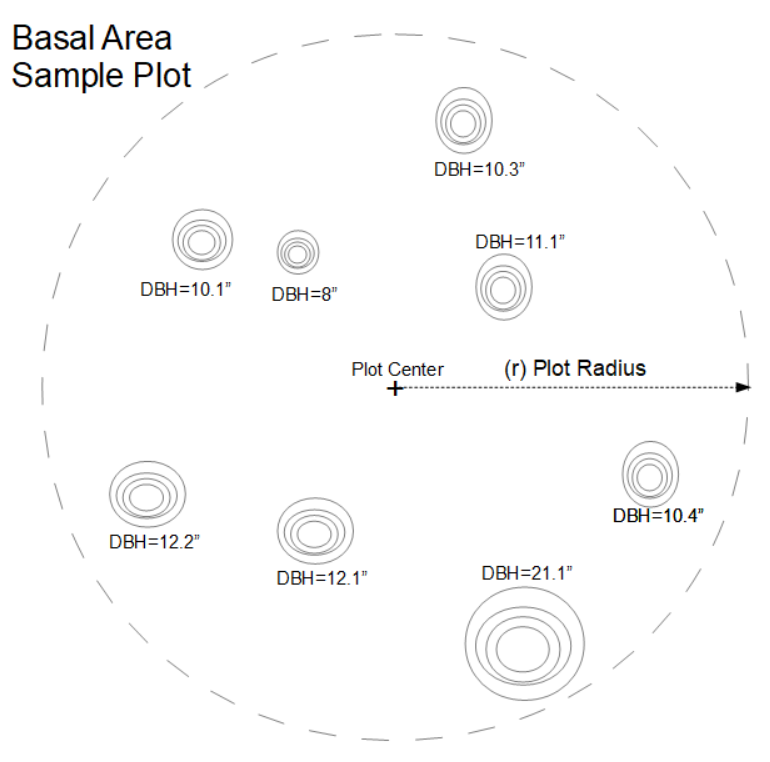Forestry Science Calculator
Forestry Calculators
- Tree Basal Area from Diameter: Computes the basal area of a tree based on the measurement of the tree's diameter at breast height.
- Tree Basal Area from Circumference: Computes the basal area of a tree based on the measurement of the tree's circumference at breast height.
- Basal Area per Acre: Computes the basal average per acre (ft2/ac) and basal average per hectare (m2/ha), based on samples and plot size.
- Volume of Maple Syrup from Sap: Computes the amount of maple syrup produced from an amount of sugar maple sap.
- Value of Maple Syrup Harvest: Computes the dollar amount associated with a number of sugar maple tree taps.
- Acreage Sample Ring: Compute the radius of a circle (e.g., 37 ft) where the area of the circle equates to an input area (e.g., 1/10th acre)
- Square Meters to Acres: Converts square meters to acres.
- Simple Stats: Computes the most common observational statistics (min, max, mean, sd, sum, sort etc) for a set of comma separated numbers.
How to Compute Basal Area per Acre
To compute the basal area per acre for a stand of trees, one can use the measurement of a sample plot and then use that plot to extrapolate for the area (acreage) of the stand of trees. Do this as follows:
- Compute the size (radius) of the circle that will be you Sample Plot. You can compute this radius using the Acreage Sample Ring function, where you enter an area size (e.g., 0.1 acres) and it returns the radius that equates to that much area. A commonly used sample plot size is 1/10th of an acre and the radius of that plot would be 37.24 feet.
- Next, choose a point in the stand of trees that seems to be a good representative of the whole stand. This location should not be too close to the edge, nor in an area that is markedly different from the rest of the stand.
- Next, use the radius of the plot to identify the trees within the circle.
- Next, measure the breast high diameter of each of the trees in the Sample Plot.
- Next, enter the values of the diameters in the Tree Basal Area per Acre function. The values should be in inches, and comma separated. For example, 10.1,8.0,10.3,11.1,12.2,12.1,21.1,10.4 for a plot of eight trees that are 110.1,8.0,10.3,11.1,12.2,12.1,21.1,10.4 in diameter respectively. Also enter the Plot Radius. Note: the default is 37.25" to equate to a 1/10th acre plot.
- The calculator will return the results including:
- (TD) Basal Area per Acre for Plot (e.g., 67.8 ft²/acre)
- (TD) Square Meters per Hectare (e.g., 15.56 m²/ha)
- (BA) Basal Area for 8 Trees (e.g., 6.78 ft²)
Equations
- Tree Basal Area from Diameter KurtHeckman Use Equation
- Tree Basal Area from Circumference KurtHeckman Use Equation
- Tree Basal Area per Acre KurtHeckman Use Equation
- Volume of Maple Syrup from Sap KurtHeckman Use Equation
- Value of Maple Syrup Harvest KurtHeckman Use Equation
- Acreage Sample Ring KurtHeckman Use Equation
- Square Meters to Acres KurtHeckman Use Equation
- Simple Stats KurtHeckman Use Equation
Wikiclips
- Comments
- Attachments
- Stats
No comments |
This site uses cookies to give you the best, most relevant experience. By continuing to browse the site you are agreeing to our use of cookies.

